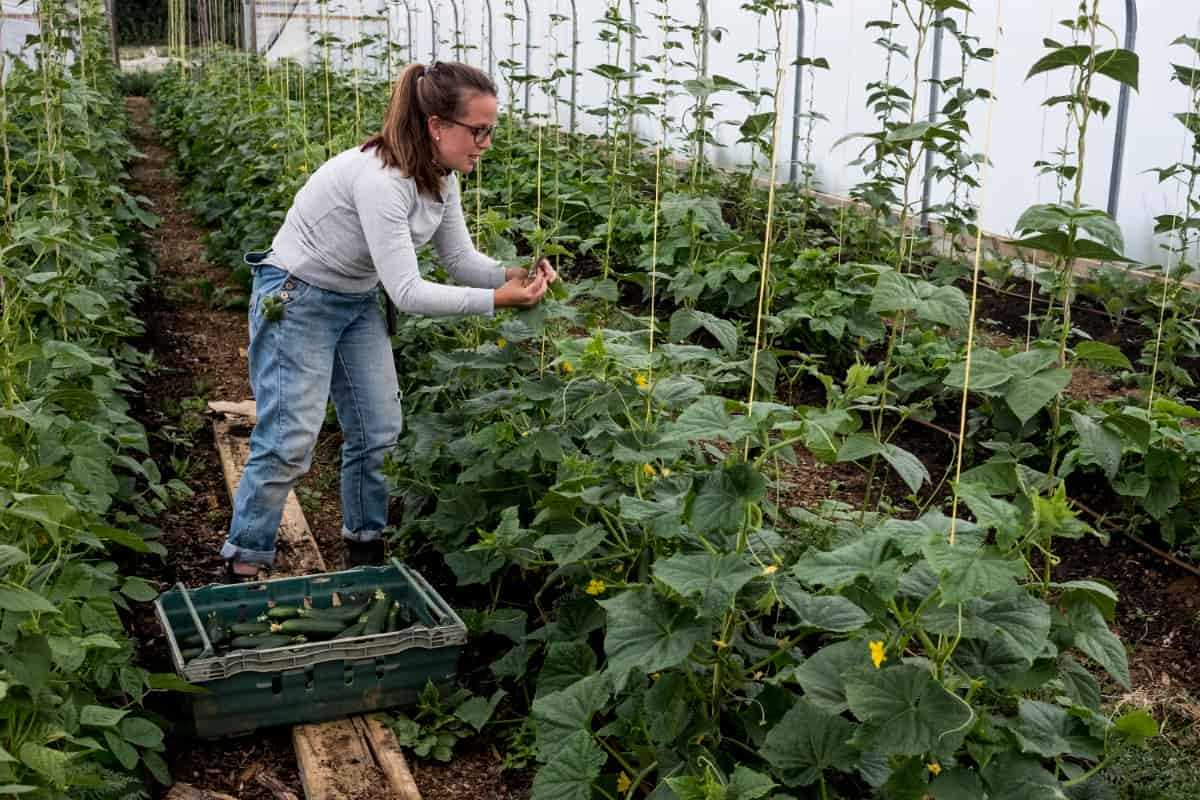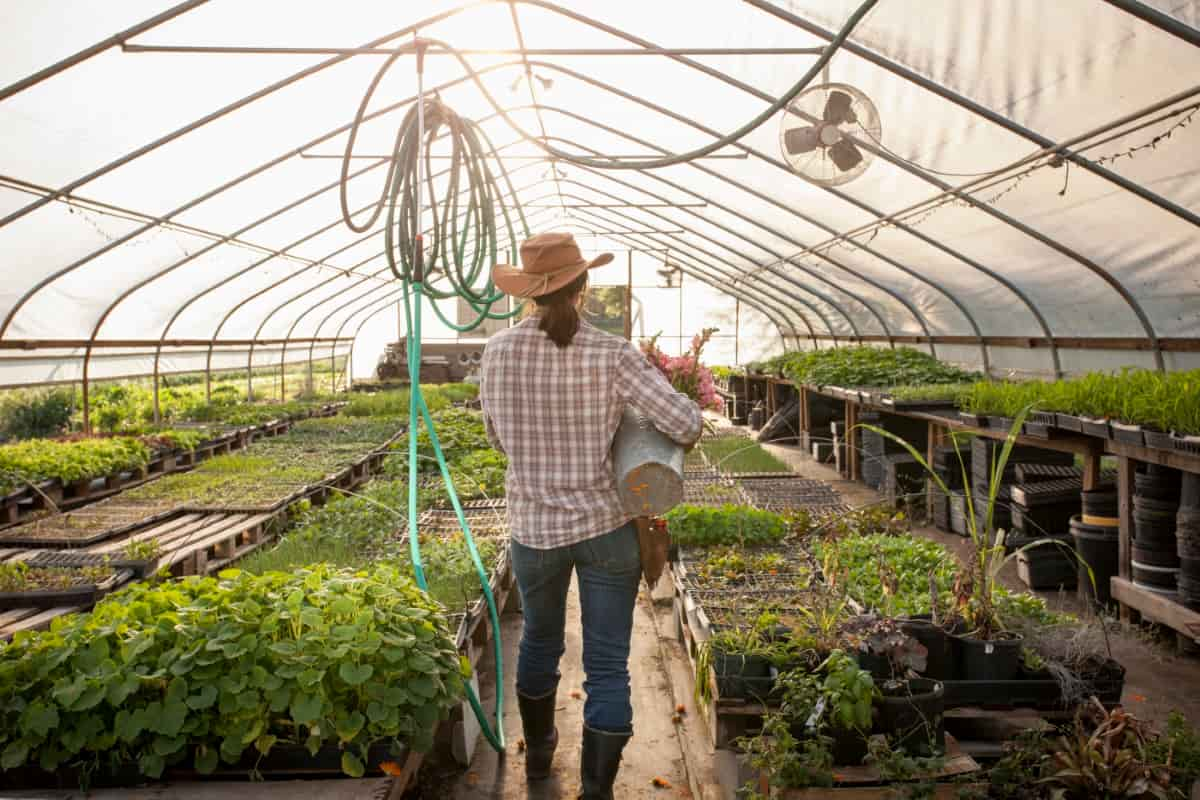Polyhouse farming is a modern agricultural technique that involves growing crops in a controlled environment using transparent materials such as polyethylene or glass. Polyhouse farming allows farmers to regulate the crops’ temperature, humidity, light, and irrigation, enhancing their quality and yield. Polyhouse farming also protects the crops from pests, diseases, and adverse weather conditions, enabling year-round cultivation of various crops.

Polyhouse Farming Cost
The Structure of Polyhouses: Size, Materials, and Components
Polyhouses are essential for growing crops, varying in size, shape, and design. They are classified into naturally ventilated and environmentally controlled polyhouses. Naturally ventilated polyhouses rely on natural air circulation and have limited control over climate parameters, suitable for low-cost and low-maintenance crops. Environmentally controlled polyhouses have sophisticated systems to regulate temperature, humidity, light, and irrigation, suitable for high-value and off-season crops.
The main components of a polyhouse include the frame, cover, ventilation system, cooling system, heating system, irrigation system, lighting system, and automation system. The frame supports the cover material and can be wood, metal, or plastic. The cover allows sunlight to enter the polyhouse. The ventilation system allows air exchange between the inside and outside of the polyhouse. The irrigation system delivers water and nutrients to the crops.
Advantages of Polyhouse Farming: Ensuring Year-Round Crop Success
Polyhouse farming offers several benefits over traditional open-field farming, including increased crop yield, improved crop quality, extended crop season, reduced water consumption, and reduced pesticide use. It can increase crop yield 5-10 times due to optimal growing conditions and reduced crop losses.
The controlled environment and reduced pest and disease incidence also enhance crop quality. Polyhouse farming also allows the cultivation of off-season and exotic crops, reducing water consumption by 70-90%. It also reduces pesticide use by 80-90% due to integrated pest management practices. Additionally, it increases income generation by producing high-value, high-demand crops.
Polyhouse Farming in India: Tackling Climate Challenges with Modern Solutions
Polyhouse farming is gaining popularity in India due to its potential to address challenges in agriculture, such as climate change, land degradation, water scarcity, food security, and rural development. It provides a stable environment for crop growth, reduces soil erosion and salinization, conserves water resources through drip irrigation and hydroponics systems, enhances food security by increasing crop productivity and diversity, and promotes rural development by creating employment opportunities for rural youth and women, improving their livelihoods and living standards.
Polyhouse Construction Costs: A Breakdown of Investments
The cost of building a polyhouse depends on several factors, including the type of polyhouse, size, location, and quality of materials used. Naturally ventilated polyhouses are cheaper due to lower capital and operational costs, while larger polyhouses are more expensive due to higher material and labor costs.
The construction cost varies regionally, and the quality of materials also affects the cost. The National Horticulture Board reports that the average cost of constructing a naturally ventilated polyhouse is Rs. 700 per square meter, while an environmentally controlled polyhouse costs Rs. 3,000 per square meter.
| Construction Type | Cost per Sq. Meter | Misting System Cost per Sq. Meter | Total Cost per Sq. Meter | Cost per Acre |
| Wooden/Bamboo Polyhouse | Rs. 500/- | Rs. 100/- (Misting) | Rs. 600/- | Rs. 20,23,500 |
| Metal Structured Polyhouse | Rs. 750/- | Rs. 100/- (Misting) | Rs. 850/- | Rs. 30,35,250 |
| Shed Net | Rs. 250/- | Rs. 200/- (Misting) | Rs. 450/- | Rs. 10,11,750 |
In case you missed it: How to Create a Polyhouse Farming Business Plan: Solid Strategies for More Yields and Profit

Polyhouse Subsidies in India: Government Support for Agricultural Innovation
India’s government offers subsidies and incentives to encourage farmers to adopt polyhouse farming for crop production and income enhancement. Major schemes include:
- The National Horticulture Mission (NHM).
- Rashtriya Krishi Vikas Yojana (RKVY).
- Mission for Integrated Development of Horticulture (MIDH).
- National Bank for Agriculture and Rural Development.
NHM provides 50% and 25% subsidies for naturally ventilated and environmentally controlled polyhouses. RKVY offers 50% and 25% subsidies for both types. MTH provides 50% and 35% subsidies for both types. NABARD also provides loans at concessional interest rates for polyhouse construction under its Rural Infrastructure Development Fund and Farm Sector Promotion Fund. Farmers can apply for subsidies by contacting their local horticulture department or visiting the NHM website.
Mukhyamantri Nutan Polyhouse Project: Empowering Farmers in Himachal Pradesh
The Mukhyamantri Nutan Polyhouse Project, launched in 2017, is a government initiative in Himachal Pradesh to support polyhouse farming. It offers an 85% subsidy for constructing a polyhouse, with the remaining 15% financed by farmers. The scheme provides technical guidance and training on crop selection, cultivation practices, pest management, and marketing. It has been implemented in all districts of Himachal Pradesh to cover 1,000 hectares by 2022. Over 600 hectares have been covered thus far, benefiting over 5,000 farmers.
Types of Polyhouses: Choosing the Right Structure for Your Agricultural Needs
Polyhouses are structures that protect plants from harsh weather and pests, extend the growing season, and increase crop yield. There are various types, including tunnel polyhouses, which are simple and low-cost. Quonset polyhouses have a semi-circular shape and a higher roof; Gothic polyhouses have a pointed arch shape; and ridge and furrow polyhouses form continuous roofs over multiple rows of plants. These structures are suitable for crops like lettuce, spinach, strawberries, tomatoes, cucumbers, and peppers and can be equipped with automated irrigation, ventilation, and shading systems.
In case you missed it: Ultimate Guide to Start an Organic Polyhouse Vegetable Garden: Creating from Scratch for Planting to Harvest

Cost Breakdown: Understanding the Financial Investment in Polyhouse Farming
The cost of establishing and operating a polyhouse farm varies based on factors like structure type, climatic conditions, chosen crops, automation level, and input availability. In India, polyhouse setup costs range from Rs. 600 to Rs. 4,000 per square meter. For a 1-acre polyhouse (4,000 sq. meters) dedicated to vegetable cultivation, estimates indicate Rs. 42 lakhs for a naturally ventilated structure and Rs. 122 lakhs for an environmentally controlled one. Recurring costs include maintenance (5-10% of initial investment per year) and operational expenses (Rs. 10 to Rs. 20 per sq. meter per month).
| Materials | Cost per Acre |
| Polyhouse sheet (Rs.55/sq.m) | Rs. 2,10,000 |
| Natural vents (Rs.600/sq.m) | Rs. 10,000 |
| Land development | Rs. 20,000 |
| Drip and Fogger | Rs. 12,500 |
| Labour (16 men) | Rs. 8,000 |
| Total Investment | Rs. 2,60,500 |
Project Report Essentials: Creating a Comprehensive Plan for Polyhouse Success
The report serves as a roadmap, detailing crucial aspects that impact the project’s outcome. Begin with an introduction outlining the project’s purpose, scope, and objectives. Provide a detailed analysis of the chosen polyhouse type, including structure, equipment, and automation levels. Discuss the climatic conditions of the location and its impact on crop selection.
Present a breakdown of costs, considering polyhouse construction, equipment, and planting materials. Include a timeline for project implementation and highlight risk management strategies. Conclude with financial projections, demonstrating the project’s viability. A well-crafted project report enhances planning, decision-making, and potential for securing subsidies or financial support.
Polyhouse Subsidies Across States: A Comparative Analysis
In Uttar Pradesh (U.P.), a recent program raised the eligible poly house size to 4,000 square meters, qualifying for an 85% subsidy. Rajasthan provides a 50% subsidy for all categories and an increased 70% subsidy for small, medium, and SC/ST farmers. In Haryana, subsidies of 65%, 90%, and 50% support the costs of polyhouses, irrigation systems, and planting materials. Madhya Pradesh offers up to a 90% subsidy to address crop-related challenges. Maharashtra, aiming for rural self-employment, extends an 85% subsidy for polyhouses.
In case you missed it: Top 5 Government Greenhouse/Polyhouse Farming Subsidy Schemes in India

Conclusion
Polyhouse farming presents a promising avenue for agricultural innovation. Government subsidies contribute significantly despite varying costs influenced by structure types and location factors. A detailed project report is pivotal for planning and securing support. The sustainable approach of polyhouse farming holds potential for year-round crop cultivation, ensuring agricultural resilience.
- Feed Your Flock for Less: Top 10 Tips to Save on Chicken Feed
- Ultimate Guide to Ossabaw Island Hog: Breeding, Raising, Diet, and Care
- Hatching Answers: The Top 10 Reasons Your Chickens Aren’t Laying Eggs
- Eggs and Economics: Breaking Down the Cost of Raising Backyard Chickens
- Defend Your Greens: Proven Methods to Keep Iguanas Out of Your Garden
- Ultimate Guide to Cinnamon Queen Chicken: A Comprehensive Guide for Beginners
- Ultimate Guide to California Tan Chicken: Breeding, Raising, Diet, Egg-Production and Care
- Ultimate Guide to Marsh Daisy Chicken: Breeding, Raising, Diet, and Care
- 10 Types of Chicken Farming Businesses You Can Start for Profits